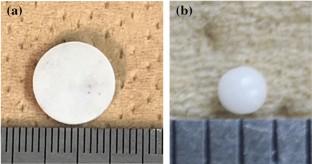International Journal of Thermophysics ( IF 2.2 ) Pub Date : 2023-12-20 , DOI: 10.1007/s10765-023-03302-2 Yifan Sun , Tomoya Takatani , Hiroaki Muta , Shun Fujieda , Toshiki Kondo , Shin Kikuchi , Florian Kargl , Yuji Ohishi

|
Aerodynamic levitation (ADL) is a widely used contactless technique for evaluating the thermophysical properties of molten materials. During data analysis, these molten samples are typically assumed to be bubble-free and to adopt an oblate spheroid shape. However, these assumptions have not been empirically validated. The presence of trapped bubbles and potential deformation at the bottom of the levitated sample, which is obscured from view by the levitation nozzle, can lead to an underestimation of the sample’s density. These factors could also interfere with the sample’s damped oscillation, thereby affecting the reliability of the measured surface tension and viscosity. Consequently, in this study, we address these issues by using smaller alumina samples to minimize sample deformation and by inspecting each sample’s cross-section after cooling for trapped bubbles. This approach enabled us to mitigate the impact of these potential distortions on the measured thermophysical properties of molten alumina. Our findings reveal that the density of dense molten alumina can be expressed as 2.917\(-\)1.228\(\times 10^{-4}\)(T-2327) [g \(\cdot \hbox {cm}^{-3}\)] from 1978 K to 2789 K. Additionally, between 2375 K and 2770 K, we determined the surface tension of alumina to be 0.632\(-\)2.310\(\times 10^{-5}\)(T-2327)[N \(\cdot \hbox {m}^{-1}\)] and the viscosity to be \(0.577e^{9.743 \times 10^{3}/\hbox {T}}\)[m \(\cdot\) Pa \(\cdot\) s].
中文翻译:

致密熔体$${\text{Al}}_{2}{\text{O}}_{3}$$的热物理性质由空气动力悬浮确定
空气动力悬浮 (ADL) 是一种广泛使用的非接触式技术,用于评估熔融材料的热物理性质。在数据分析过程中,这些熔融样品通常被假设为无气泡且呈扁球体形状。然而,这些假设尚未得到实证验证。悬浮样品底部存在滞留气泡和潜在变形(被悬浮喷嘴遮挡,无法看到),可能会导致样品密度的低估。这些因素还可能干扰样品的阻尼振荡,从而影响测量的表面张力和粘度的可靠性。因此,在本研究中,我们通过使用较小的氧化铝样品来最大程度地减少样品变形并通过检查冷却后每个样品的横截面是否有气泡来解决这些问题。这种方法使我们能够减轻这些潜在变形对测量的熔融氧化铝热物理性质的影响。我们的研究结果表明,致密熔融氧化铝的密度可表示为 2.917 \(-\) 1.228 \(\times 10^{-4}\) (T-2327) [g \(\cdot \hbox {cm}^ {-3}\) ]从1978 K到2789 K。此外,在2375 K到2770 K之间,我们确定氧化铝的表面张力为0.632 \(-\) 2.310 \(\times 10^{-5}\ ) (T-2327)[N \(\cdot \hbox {m}^{-1}\) ] 且粘度为\(0.577e^{9.743 \times 10^{3}/\hbox {T} }\) [m \(\cdot\) Pa \(\cdot\) s]。



























 京公网安备 11010802027423号
京公网安备 11010802027423号